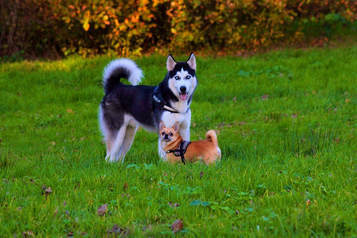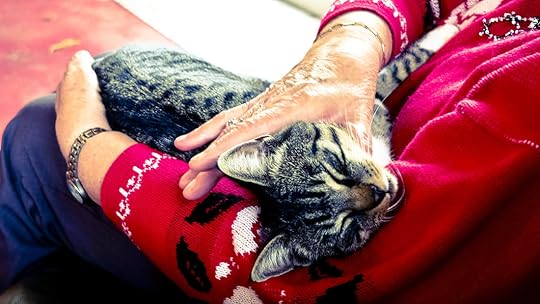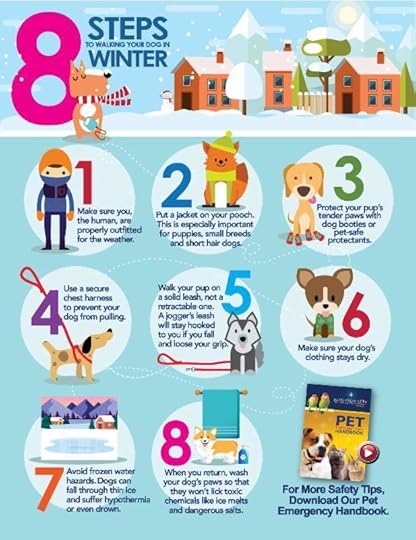Gayle Irwin's Blog, page 18
February 5, 2018
be someone's hallmark valentine!
 February is known for two main things: Valentine’s Day and Hallmark Movies’ love-stories.
February is known for two main things: Valentine’s Day and Hallmark Movies’ love-stories.Love is a Hallmark movie… well, not for everyone, and certainly not for every companion animal. Pets are called companion animals for a reason – to provide companionship to people, to be devoted, loving, faithful… and they would be, if only we let them. Instead, many cats, dogs, rabbits, guinea pigs, even turtles and lizards are mistreated, neglected, and abused. Where is their Hallmark Valentine hero/heroine?
In truth, humans and animals share this one thing in common: rejection. The person you love and trusted abandons you, mistreats you, breaks your heart and spirit. Yet, many people and pets have another thing in common: resiliency. We pull ourselves up by our bootstraps, as they say, and carry on. That perseverance may take months, even years, but when we dig deep inside ourselves and we let others help and encourage us, we discover that fortitude and we move ahead to a brighter future.
For animals as well as us, that brighter future involves compassionate, kind people. When you watch a Hallmark movie, friends surround the broken-hearted, hurt individual, encouraging them to be open to love again. And, surprise, surprise, s/he comes along! That can be true for pets as well. Rescues, SPCAs, Humane Societies, and others step forward to lift pets’ spirits, saving their lives from abuse and neglect, and then prepare them for adoption. But, there needs to be more adopters, more heroes and heroines to help the light shine more deeply into the spirits of those animals cast-away, those treated not just poorly, but many times cruelly.
Can you be an animal’s Hallmark Valentine this year?
Five years ago, my husband and I adopted a springer/cocker mix named Mary. She wasn’t abused or neglected; in fact, she was deeply cared for by her previous owner. Sadly, that person died, and Mary needed a new loving family. Greg and I answered the call, and we have been her Valentine ever since! She is devoted to us and she has also impacted others, serving sometimes as a library read-to-the-dog companion, nestled among a group of children and giving them affection as well as courage. Her stories which I’ve written take kids on adventures and teach them lessons like kindness, friendship, and joy. I love sharing Mary with others and teaching them the value of adoption.
Then, there’s Jeremiah, whom we adopted last fall. He came from a puppy mill, serving as a stud for three years. He lost 28 teeth due to poor nutrition and came to us from a rescue still timid and uncertain about living in a house. Now, five months later, he realizes kindness and compassion can come from human beings, and he’s settled in well, with Mary as his best friend. He walks proudly on a leash, dashes through our fenced-in backyard with joy, and cuddles next to me on the couch with thankfulness on his face. His Valentine’s Day gift this year is a warm home and caring people (plus a canine BFF!)
Even if we, as a man or woman, have been rejected by human love, there’s a way to share our love. Numerous animals – dogs, cats, horses, rabbits, birds, guinea pigs, and others – are waiting for their special Valentine. Nearly 1.5 million dogs and cats die in kill-shelters every year, and more than 10,000 animal mill facilities confine creatures (especially dogs and cats) simply for the act of breeding. They lack socialization and medical care. Several rescues, such as National Mill Dog Rescue and Hearts United for Animals, take in these animals and care for them while searching for loving, permanent homes for them to call their own, i.e., for their special Valentine.
Find your four-footed Valentine this month, knowing that creature will be devoted to you for its life, and then make some popcorn and sit on the couch together while enjoying some Hallmark movies!
NOTE: The Hallmark Channel features several films in which animals play important roles. Check out titles such as Like Cats and Dogs; Love at First Bark; Walking the Dog; and Eat, Play, Love -- some of these are scheduled this month and others in March. Enjoy, and especially enjoy your furry Valentine!

Published on February 05, 2018 14:48
January 29, 2018
learn about dog breeds before bringing a pup home
 When considering adding a dog to your household, how do you know which is the right one for you? One way is to understand the needs of the various breeds. And, there’s a great many types of dogs out there! Therefore, choose one that fits your lifestyle.
When considering adding a dog to your household, how do you know which is the right one for you? One way is to understand the needs of the various breeds. And, there’s a great many types of dogs out there! Therefore, choose one that fits your lifestyle.Do Your Research.
Each breed has a different personality, activity level, and size. Mixed breeds, too, will have their own character traits, likely taking some from one breed and other characteristics from the other. For example, a goldendoodle may have the curly hair of the poodle and the personality of the golden retriever … or vice-versa.
How do you know the various breeds’ needs, size, and personality? One of the best online resources is provided by the American Kennel Club (AKC). You’ll find information about different types of dogs here: http://www.akc.org/dog-breeds/.
Westminster Dog Show/AKC
Another fun way to learn about the various dog breeds is through your television set. The Westminster Kennel Club Dog Show takes place February 12 and 13; it will be broadcast in the U.S. on Fox Sports and NatGeoWild. Watching the program, you’ll learn more about the different dog breeds as they appear on stage. You can also learn about dog breeds from the organization’s website: http://www.westminsterkennelclub.org/breed-finder/. And though the AKC and Westminster Show promote breeding of dogs and encourage people to buy from breeders, they do stress no dogs on the show come from pet stores or puppy mills. Personally, I will always adopt, but I recognize the value of understanding breeds before adoption. Knowing what type of dog is best for you before you adopt is much better for you and for the dog you bring home: less frustration, less chance the dog will end up back at the shelter in less than a year. Westminster’s website also provides information on choosing the right dog for you and your lifestyle: http://www.westminsterkennelclub.org/find-the-right-dog-for-you/.
Spaniels and Shih Tzus
When my husband and I began searching for another dog to add to our household last fall, our first choice was another spaniel. We’ve been blessed to share life with springer and cocker spaniels, and we both enjoy the breeds. Although originally developed for hunting, springers and cockers have become popular simply as companions, particularly cockers. We’ve experienced their loyalty and friendliness; however, cockers tend to be snippier with young children. Since we don’t have children in our household, we didn’t worry about that. Turns out neither cocker spaniel we lived with had a problem with kids; in fact, one made several schools visits with me for author talks.
So, what dog would we adopt this time? We inquired about some spaniels early in our search, but (not surprisingly) they were adopted quickly. Knowing I wanted a small dog because I am aging, we began to expand our horizons. The Shih Tzu is known to be affectionate, playful, and outgoing, can live to be 15 years old, and usually weighs 12 to 15 pounds (females smaller). We discovered a four-year-old rescued from a puppy mill available through a regional pet rescue sanctuary. He was still available for adoption when we inquired, and our adoption application was approved. Jeremiah came to live with us in September 2017, and though he had some issues, medically and behaviorally from spending three years as a puppy mill stud, he has settled in wonderfully. Jeremiah and Mary, our springer-cocker mix whom we adopted in January 2013, have bonded nicely, and Jeremiah’s happiness living in a loving home is apparent when he dances as I come through the door and as he prances around the neighborhood during a walk. He’s learned the leash takes him places to explore, and that toys are fun to fetch. And, his cuddles on the couch bring out that affection to us, and our fingers scratching his belly relax him and shower him with the love he never really experienced.
Who Will Be Your Next Dog?
As you consider adding a dog to your household in the future, learning about the different dog breeds will benefit you … and the dog you eventually bring home.
Check out this other online resource to learn about various dog breeds: https://www.jenreviews.com/dog-breeds/
 Our recently adopted puppy mill survivor, Jeremiah, considers our springer/cocker mix, Mary, his best friend.
Our recently adopted puppy mill survivor, Jeremiah, considers our springer/cocker mix, Mary, his best friend.
Published on January 29, 2018 12:11
January 23, 2018
change a pet's life day
 Do you know you can change a pet’s life? Wednesday, January 24, is designated Change a Pet’s Life Day, and you can help do that.
Do you know you can change a pet’s life? Wednesday, January 24, is designated Change a Pet’s Life Day, and you can help do that.Change a Pet’s Life Day started in 2009 to draw attention to the many homeless pets and to encourage adoption, bring awareness to animal welfare issues, and, for many, to establish a time to celebrate shelter/rescue workers and volunteers, who make a difference in the lives of homeless animals every day. All of us can do something to positively change the lives of animals. One of those ways, and an important one, is to adopt.
Every year, millions of animals are brought into animal shelters and rescues. Although adoption rates have increased during the past two decades, there are still about 50 percent that are not. Therefore, as a society, we still have a long way to go and improvements to make regarding pet adoption.
However, for some, adoption isn’t always possible. If that is you, what are other ways you can change a pet’s life? Here are a few ideas:
Donate to a shelter or rescue. Whether you contribute funds or provide food for the animals, your donation helps shelters and rescues operate.Volunteer. All animal welfare organizations need volunteers. Foster families, event helpers, dog walkers, cat socializers, painters, landscapers… a variety of volunteer positions are necessary to help groups help animals find their forever homes.Support community events that support animals in need. Is there a 5K walk/run coming up that benefits your local rescue or shelter (ThinkIf you do decide to adopt another pet, it’s important to choose the animal that’s right for your lifestyle. Learn about the variety of dog and cat breeds, including their personalities and needs, from these sources:
Dogs
American Kennel Club -- http://www.akc.org/dog-breeds/?_ga=2.126130569.505065269.1516415304-2085044977.1514578697
Dogtime -- http://dogtime.com/dog-breeds/profiles
Jen’s Reviews -- https://www.jenreviews.com/dog-breeds/
Cats
Cattime -- http://cattime.com/cat-breeds
Purina -- https://www.purina.com/cats/cat-breeds
Petfinder -- https://www.petfinder.com/cat-breeds/
What will you do this week to change a pet’s life?
This is not the only special pet day this week, this month, or this year. There are many special pet holidays, including yesterday’s National Answer Your Cat’s Questions Day. For a run-down of the rest of 2018’s special days honoring animals, visit this site: https://www.dogtipper.com/fun/pet-holidays.

Published on January 23, 2018 04:30
January 16, 2018
5 reasons to walk your pet - even in winter
 For many people, January brings thoughts of better health – new year, new you. We can also resolve to get (or keep) our pets healthier, even if we haven’t started yet. One of the easiest ways for people, and pets, to become (or stay) healthier is by walking.
For many people, January brings thoughts of better health – new year, new you. We can also resolve to get (or keep) our pets healthier, even if we haven’t started yet. One of the easiest ways for people, and pets, to become (or stay) healthier is by walking.January is Walk Your Pet Month. Here are five good reasons to walk your pet:
Curbs obesity. Overweight pets are common, according to the Association for Pet Obesity Prevention, and that extra weight is unhealthy for them, causing medical issues such as respiratory conditions, liver and kidney disorders, and joint inflammation. Obesity impacts life expectancy as well.Overcoming boredom. Pets left alone for hours while the humans are at work or school can become bored, and when bored, they may become destructive. Therefore, interacting with the outdoors and exploring the neighborhood via a walk in the morning, afternoon, or evening will help your pet mentally as well as physically.Increases socialization opportunities. Whether strolling through a park or around the neighborhood, your pet receives opportunities to engage with other animals and people. That’s a benefit for you, too. Pet-lovers often converse with other pet-lovers, broadening the scope of human connection, which is emotionally and mentally healthy for us in this technological era.Strengthens your bond. Spending time with your pet while walking increases the connection between the two of you. Such quality time is important to your pet’s behavioral development, generating increased trust and bonding.Promotes better health in you, too. According to the Mayo Clinic, walking helps manage heart disease, high blood pressure, weight, and depression. It’s a quality exercise nearly every person can do.
If your dog is one of those that doesn’t walk well on a leash, and therefore, you avoid walks with your canine friend, there are many avenues you can take to train him/her. One includes visiting PetCo or PetSmart and enrolling in a training program offered at the store or enrolling in a class offered by your local Kennel Club chapter. Another is to hire a trainer. Or, you can do it yourself by reviewing instructions on sites like YouTube. There are also many great articles online about training your dog, including ones by Cesar Milan and the American Kennel Club, which you’ll find below:
https://www.cesarsway.com/dog-training/walking/6-tips-for-mastering-the-dog-walk
http://www.akc.org/content/dog-training/articles/teach-puppy-walk-leash/
Dogs aren’t the only pets that can be trained to walk on a leash – ferrets can as well and so can cats. Both my mother and I have had cats that were leash-trained, and when I visited and volunteered at Best Friends Animal Sanctuary in southern Utah, I took one cat for a walk on a leash and took another for a stroll in a baby buggy. Walking on a harness and leash allows kitties to explore the outdoors and breath fresh air safely. Learn how to train your cat to walk well on a leash by visiting this Best Friends’ site: https://bestfriends.org/resources/walking-cat.
Even though winter is upon us, walking with your pet outdoors can still be done. See the infographic below, created by NorthStar VETS of New Jersey, on how to walk safely outdoors with your pet during the cold and snowy months.
Keep your New Year’s resolution to get and stay healthy – and resolve to keep your pet healthy, too, – by sharing quality walks with your furry friend.

Published on January 16, 2018 05:00
January 9, 2018
The need for rescues, the need for responsibility
 Living in the 21st century has many perks, from technological gadgets to how, as a society, we view animals. According to the American Pet Products Association, 68 percent of people living in the United States own a pet, with the majority (60.2 million) having dogs and 47.1 million having cats. The organization estimates that nearly $70 billion was spent on pets by pet owners in 2017, up from 66.75 billion in 2016. Americans certainly seem to love their pets!
Living in the 21st century has many perks, from technological gadgets to how, as a society, we view animals. According to the American Pet Products Association, 68 percent of people living in the United States own a pet, with the majority (60.2 million) having dogs and 47.1 million having cats. The organization estimates that nearly $70 billion was spent on pets by pet owners in 2017, up from 66.75 billion in 2016. Americans certainly seem to love their pets!Still, improvements are greatly needed, especially in the areas of animal adoption and pet ownership responsibility.
According to the American Society for the Prevention of Cruelty to Animals (ASPCA), nearly 6.5 million animals enter shelters and rescues every year; they are comprised of owner surrenders, strays, and animals rescued from hoarding, dog fighting, and puppy/kitty mill operations. Only about half are adopted. More than 700,000 strays are reunited with their owners; sadly, less than five percent of the cats that come in as strays are reclaimed, and many of the animals brought in are not spayed or neutered.
Pet ownership responsibility includes caring for one’s animal, providing food, water, shelter, and medical treatment. In addition to vaccinations and teeth cleaning, medical care should include spaying and neutering. Such procedures curb the number of litters born, and therefore, helps cut down on the number of animals needing homes, either through the owner giving/selling the youngsters or taking them to rescues and shelters. Cats and dogs can breed two to three times a year, having an average of six babies per litter. Multiple that out over the course of five to seven years, and you have thousands more animals per unsprayed female. For every kitten or puppy sold or given away by owners, that’s one less adopted and therefore, one more possibly euthanized.
Until there are less strays, less owner relinquishment, more adoptions, and more spaying and neutering, no more animal hoarding or puppy/kitten mills, there will be the need for animal shelters and rescues.
We all can do our part to positively impact responsibility and rescue. Here are some suggestions:
Spay and neuter our pets.Make sure your animals have collar/ID tags and/or microchip with updated, correct contact information.Search for your pet if it becomes lost, and that includes visiting your local animal shelter(s) and reclaiming your pet.Be a good Samaritan and help a lost animal get back home, which can include reporting loose animals to your community’s animal control.Educate others about the importance and benefits of spaying and neutering.Volunteer at your local shelter and/or become a foster family.Teach your children and grandchildren kindness to animals.Report suspected neglect and abuse, including dog fighting.Adopt your next pet.Encourage pet adoption and pet ownership responsibility to others.Donate to your local shelter or rescue, whether money or supplies.Attend events benefitting your local rescue/shelter.
Although America has come a long way since the 1970s when 12 to 20 million pets were killed in animal shelters across the country, there a great need still exists for pet ownership responsibility and, therefore, for animal rescues and shelters. Let’s all do something to help continue the downward trend of euthanasia rates and increase pet ownership responsibility. Maybe one we will realize the #NoKill dream many animal welfare organizations envision – that no healthy, adoptable animal is euthanized – but it takes responsible pet owners to get there.

Published on January 09, 2018 04:00
January 2, 2018
6 tips for keeping your pet warm this winter
 A new year has dawned with blasts of arctic air ushering in 2018 in the United States. From coast to coast, sub-zero temperatures and wind chills have taken their icy grip. These freezing temperatures not only affect people, but they also impact animals, including our pets. As caregivers to our furry family members, we need to insure our beloved companions are safe, warm, and healthy during this cold season. Although they have fur, and some breeds have extra-thick coats, the bitter temperatures do impact pets. Preventing frostbite and hypothermia saves our animals from injury, even death.
A new year has dawned with blasts of arctic air ushering in 2018 in the United States. From coast to coast, sub-zero temperatures and wind chills have taken their icy grip. These freezing temperatures not only affect people, but they also impact animals, including our pets. As caregivers to our furry family members, we need to insure our beloved companions are safe, warm, and healthy during this cold season. Although they have fur, and some breeds have extra-thick coats, the bitter temperatures do impact pets. Preventing frostbite and hypothermia saves our animals from injury, even death.Here are six tips for keeping your pet warm during these frosty months:
If you walk or play with your dog outdoors on a frigid day, do so when the sun the shining and the temperature is warmest, generally mid-morning to mid-afternoon. The sun provides vitamin D, which is good for both people and pets.Be especially attentive to the pads of paws. Feet, ears, and tails are most susceptible to frostbite, and paws can pick up debris and ice melt – therefore, clean your pet’s pads when returning indoors. Also, you may want to invest in booties to help protect your furry friend’s feet.Cold as well as dry weather can affect your pet’s skin just as it can your own. Add a skin/coat supplement to your animal’s diet to help prevent dry, flakey skin. You might also try coconut oil as a moisturizer, applied directly onto the skin or coat.Keep your animal hydrated. Animals need water as much in winter as they do in summer. Therefore, insure your pet has plenty of fresh drinking water every day.Help your pet deal with the pain of arthritis. Cold weather makes arthritis even more uncomfortable. Therefore, if you have a senior animal, or one that experiences arthritis, provide a supplement for joint care and ensure your pet gets the exercise it needs to lubricate those achy areas.Provide warm bedding for your beloved pet. Blankets, dog/cat beds, and other cozy comforts will keep your animal warm during the harsh winter season. Just as we often use quilts, afghans, and other toasty materials to keep us warm, our pets also need more than a cold floor on which to lie. And, please don’t leave your dog chained up or kenneled outside during these freezing temperatures – short-haired dogs in particular can (and do) freeze and die when left outdoors.
As we dive into this winter season, following these guidelines can keep your pet safe and healthy during the brutal battle of arctic air we’re experiencing. For more thoughts on winter safety for your pet, visit these websites:
https://pets.webmd.com/dogs/features/dog-cold-weather-tips#1
and
http://www.dogsnaturallymagazine.com/15-winter-care-tips-for-your-dog/

Published on January 02, 2018 04:30
December 26, 2017
be wary of ice melts this winter
 As Old Man Winter barrels down on much of the United States, snow and ice build up on sidewalks and driveways. To rid our walkways of the dangers of icy conditions, which can lead to falls and broken bones, we often put down ice melt. However, those can have their own hazards, especially for our pets.
As Old Man Winter barrels down on much of the United States, snow and ice build up on sidewalks and driveways. To rid our walkways of the dangers of icy conditions, which can lead to falls and broken bones, we often put down ice melt. However, those can have their own hazards, especially for our pets.The primary ingredient in most ice melt products can be sodium chloride or calcium chloride. These substances can irritate the paws of pets and can also be harmful, even deadly, if ingested. A dog or cat that’s been outside and picks up salt or ice melt on its feet then licks its paw after coming indoors could experience vomiting or diarrhea. Even just a few ounces of sodium chloride or calcium chloride in a small dog or cat can be deadly.
There are two positive solutions to ice melt concerns.Use less toxic products, such as Safe Paws or Morton Safe-T-Pet. No ice melt should be considered entirely safe; however, these types contain urea, and are not as harmful, causing upset stomach and drooling.Place boots or socks on your pets when they are outside, especially when walking your dog. Not knowing what types of ice melts your neighbors use on their sidewalks and driveways, covering on your pets’ feet will help protect them from any type of salt product being used.
Crystals from salt and ice melt can get between your pet’s pads, causing irritation and potential burns. Take time to clean your dogs’ feet after a walk and your cats’ paws if they venture outdoors during winter. Paying close attention to your animals’ feet will help keep them more safe and healthy during these snowy months.
For some references on ice melts, visit these websites:
http://www.dogsnaturallymagazine.com/finding-paw-friendly-ice-melt-products/
https://topdogtips.com/best-ice-melt-safe-for-pets/
http://www.akc.org/content/dog-care/articles/morton-safe-t-pet/
https://www.epicgardening.com/best-ice-melt/
If your pet ingests ice melt, contact your vet, the Pet Poison Helpline (800-213-6680), or the ASPCA’s Animal Poison Control Center (888-426-4435).

Published on December 26, 2017 12:25
December 19, 2017
holiday safety tips for pet parents
 Christmas is just a few short days away. Nothing can ruin the holiday season quicker than a health emergency, whether it involves a human or a beloved pet. The American Veterinary Medical Association lists several things that you as a pet parent can avoid in order to keep your pets healthy and safe. Here are a few:
Christmas is just a few short days away. Nothing can ruin the holiday season quicker than a health emergency, whether it involves a human or a beloved pet. The American Veterinary Medical Association lists several things that you as a pet parent can avoid in order to keep your pets healthy and safe. Here are a few:Keep people food out of your pet’s reach and ask any guests you may have to do the same. That includes people treats, especially those containing chocolate, grapes, raisins, and onions.Don't leave your pet alone in a room with lit candles – a house fire isn’t a good thing to experience during the holidays.Keep holiday plants (such as holly, mistletoe and lilies) out of reach of your pets.If you have a cat, you may want to leave tinsel off your Christmas tree – shiny and sparkly items like tinsel attract cats’ attention and your furry feline can cause havoc to your tree.Secure that Christmas tree to keep it from falling over if your dog bumps it or your cat climbs it.Provide a safe, quiet place for your pet to escape the excitement (such as a kennel, crate, perching place, scratching post shelf or special room). This is especially beneficial if you’re entertaining/expecting guests. If you do put your pet in another room, also place some toys and a comfortable bed in that space.Keep your veterinarian’s number handy (or the number to the closest emergency vet) as well as the ASPCA’s Poison Control Hotline (1-888-426-4435) in case your pet becomes poisoned or injured in some other way.
Safety applies to travel as well. GoPetFriendly lists some tips for holiday car traveling and home visits with your pet, including:Staying with relatives or friends? Make sure your pet will be welcomed and ask your hosts the rules of their house beforehand – your pet may need a refresher course on obedience commands.Pack your animal’s favorite toys and treats to help keep them entertained during your stay as well as familiar items like your pet’s bed and blanket.Make sure your pet has an ID tag (and that s/he is wearing a collar with the tags attached) and/or is microchipped – lost pets does not make for a happy holiday for either of you!If you need a pet sitter or dog walker, whether you’re traveling, visiting, or staying home, see Rover.com to find a reputable helper.If you’re staying at hotels during your travels, visit GoPetFriendly or BringFido to find lodging, activities, and restaurants which accommodate pets.Whether staying in your own home or visiting someone else’s, make sure your pet has its own quiet place, a spot (a room, a crate) where it can get away from the noise and excitement of the holiday season.
For airline travel safety trips, visit http://www.travelchannel.com/interests/pets/articles/holiday-pet-travel-guide.
Find more thoughts on holiday pet safety at these websites:
https://www.avma.org/public/PetCare/Pages/holidays.aspx
https://www.aspca.org/pet-care/general-pet-care/holiday-safety-tips
http://www.humanesociety.org/animals/resources/tips/traveling_tips_pets_ships_planes_trains.html
and
https://blog.gopetfriendly.com/pet-travel-tips-for-the-holidays/
Merry Christmas to you and your beloved furry ones!

Published on December 19, 2017 05:00
December 13, 2017
christmas gift ideas for your pet
 “The stockings were hung by the chimney with care…” so goes the poem written by Clement Moore called ‘Twas the Night Before Christmas. So, the stockings are ready, the Christmas tree stands stately in the living room, and the outdoor lights sparkle with the season. Gift shopping commences, and you don’t want to forget the furry ones in your family. What do you get your beloved cat and/or dog companion?
“The stockings were hung by the chimney with care…” so goes the poem written by Clement Moore called ‘Twas the Night Before Christmas. So, the stockings are ready, the Christmas tree stands stately in the living room, and the outdoor lights sparkle with the season. Gift shopping commences, and you don’t want to forget the furry ones in your family. What do you get your beloved cat and/or dog companion?From toys and treats to beds and trees, there’s a myriad of gift ideas for our pets. Articles made by hand (your own or someone else’s) or typical box-store items… which do we get? Maybe a mix of both. Here are a few gift ideas for your special pet this year:Toys – whether a feather toy for your kitty or a rope/tug toy for your dog, play is good for our pets. Exercise is vital to their emotional and physical health, and playing with your pet is good for you as well. KONG makes toys for both dogs and cats, and this company’s products can be purchased online or in-store, particularly at the box stores like PetSmart and PetCo.Beds and Blankets – what is cozier during this cold season than a warm bed and/or blanket? Keep your pets warm this winter with a nice bed or a fleece blanket your dog or cat can crawl into.Scratching posts and Trees for cats – kitties need to scratch to keep their claws from growing too long; they also enjoy being above the foray of the household. Scratching posts and climbing trees meet those needs, and can be purchased at just about any store.Clothing – small dogs in particular can often use a sweater or coat during the cold winter months. A variety of clothing items, from sweat shirts and sweaters to boots and rain jackets, are available should you decide to “dress up” your special furry friend.Treats – homemade biscuits, dental chews, soft morsels, and many other types of treats are usually welcomed by our pets. There are many varieties and different flavors from which to choose.
Whether you make your own gifts for your pets or buy online or in-store, Christmas presents for our pets are fun to give – our beloved dogs and cats often get as excited as young children to receive Christmas presents. Just remember to keep your spending in check (see previous blog post).
For a variety of pet gift ideas at a low cost, read these recently published articles:
Woman’s Day : http://www.womansday.com/life/pet-care/g946/pet-gifts/?slide=2
Town and Country : http://www.townandcountrymag.com/style/tips/g2993/best-pet-gifts/

Published on December 13, 2017 06:07
December 5, 2017
holiday splurging and spending on pets
 Are you like me during the holiday season and hang Christmas stockings filled with goodies for your pets? Do you splurge, spoil, and spend hard-earned cash on your animals, especially at this time of year?
Are you like me during the holiday season and hang Christmas stockings filled with goodies for your pets? Do you splurge, spoil, and spend hard-earned cash on your animals, especially at this time of year? Although it’s fun to make our pets feel special, just as we are delighted to enhance all of our loved ones’ holiday, whether it’s kids, grandkids, spouses, or parents, we also need to be wise to not over-indulge. As author, speaker, and radio show host Dave Ramsey says, “You can have a giving spirit without having a negative checking account.”
Here are a few tips for not breaking the bank this Christmas:
Set a budget and stick to it. Many people average spending $1,000 on gifts – look for ways to cut that down, perhaps even halving it. Regarding your pets: instead of spending $50 to $100, spend just $25 – you can get a lot of toys and treats for $25 and under!
Create gifts. You can make toys for your pets easily. Visit https://lifehacker.com/the-best-diy-pet-toys-you-can-make-from-stuff-in-your-h-1794060959 for ideas. And, for DIY gifts for family and friends, visit http://www.getrichslowly.org/2008/11/13/a-do-it-yourself-christmas-34-great-gifts-you-can-make-yourself/.
Make a list and don't waver. Visiting the mall or going online can cause more spending than necessary if you don’t have a gift list. Create your present-gifting list and don’t waver from it, no matter how tempted you might be.
Research to find the best deal. Check out sites like retailmenot.com and ebates.com as well as clip coupons from circulars and newspapers – you may not only find bargains for the humans on your list, but also for your beloved pets. Amazon, Chewy.com, PetCo, and PetSmart often have online deals for pet parents as well. Check out ideas here: https://www.moneytalksnews.com/28-ways-save-big-bucks-pet-supplies/.
People do spend money on their pets. According to the American Pet Products Association, the amount of money people spend on their pets increases every year. In 2015, pet parents spent just over $60 billion (yes, billion with a “b!”) dollars on their animals; the following year, that amount increased to more than $66 billion, and in 2017, the organization predicts pet owners will spend nearly $70 billion dollars. Dogtime reports that $20 billion is spent on Halloween costumes, but Christmas gifts vie for an important role in pet-parent spending as well, averaging $36 per pet in the United States (pet parents in England spend a tad more, about $46 per pet).
There are NUMEROUS pet gift ideas, from Amazon picks to items at the big box stores. Some of the most delightful suggestions I’ve seen are listed/linked below:
http://www.goodhousekeeping.com/holidays/gift-ideas/g474/pet-gifts/?
http://www.townandcountrymag.com/style/tips/g2993/best-pet-gifts/
In addition to Christmas gifts and everyday items like pet food, medical care for pets is also an expense – and can have a major effect on people’s finances. As we all know, pet care takes a lot of green (or plastic), whether that’s staples like food or for medical care. There are organizations and agencies, in states and nationally, who can help with various pet care costs, from spay/neuter procedures to prescription drugs. The Simple Dollar provides an online guide to these groups; check out your state’s pet organizations and foundations, as well as the national groups, by visiting this Simple Dollar website: http://www.dogingtonpost.com/over-the-counter-medications-that-are-safe-for-dogs-and-how-much-to-give/.
Enjoy the holiday season without getting into financial hot water come January! And, if you need extra help with pet care needs, consider the resources listed at The Simple Dollar.

Published on December 05, 2017 05:30



